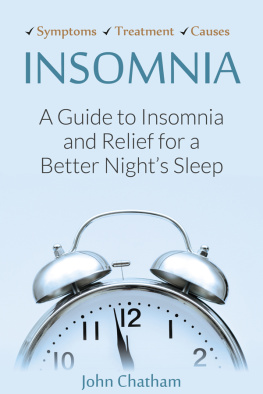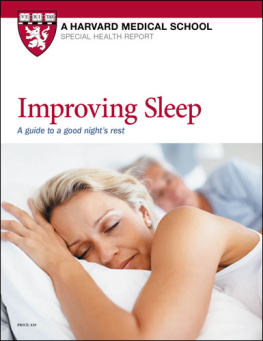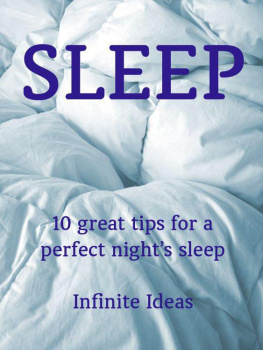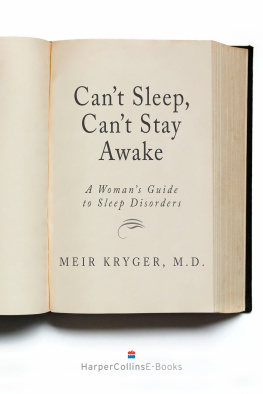THE
HARVARD MEDICAL
SCHOOL GUIDE TO
A Good Nights
Sleep
Also from Harvard Medical School
The Harvard Medical School Guide to Healthy Eating During Pregnancy, by W. Allan Walker, M.D., with Courtney Humphries
The Harvard Medical School Guide to Achieving Optimal Memory, by Aaron P. Nelson, Ph.D., with Susan Gilbert
The Harvard Medical School Guide to Lowering Your Cholesterol, by Mason W. Freeman, M.D., with Christine Junge
The Harvard Medical School Guide to Healing Your Sinuses, by Ralph B. Metson, M.D., with Steven Mardon
The Harvard Medical School Guide to Overcoming Thyroid Problems, by Jeffrey R. Garber, M.D., with Sandra Sardella White
The Harvard Medical School Guide to Lowering Your Blood Pressure, by Aggie Casey, R.N., M.S., and Herbert Benson, M.D., with Brian ONeill
Living Through Breast Cancer, by Carolyn M. Kaelin, M.D., M.P.H., with Francesca Coltrera
The Breast Cancer Survivors Fitness Plan, by Carolyn M. Kaelin, M.D., M.P.H., Francesca Coltrera, Josie Gardiner, and Joy Prouty
Hot Flashes, Hormones, and Your Health, by JoAnne E. Manson, M.D., with Shari S. Bassuk, Sc.D.
Beating Diabetes, by David M. Nathan, M.D., and Linda Delahanty, M.S., RD
Eat, Play, and Be Healthy, by W. Allan Walker, M.D., with Courtney Humphries
The No Sweat Exercise Plan, by Harvey B. Simon, M.D.
THE HARVARD MEDICAL SCHOOL GUIDE TO
A Good Nights Sleep
LAWRENCE J. EPSTEIN, M.D.,
WITH STEVEN MARDON


Copyright 2007 by the President and Fellows of Harvard College. All rights reserved. Except as permitted under the United States Copyright Act of 1976, no part of this publication may be reproduced or distributed in any form or by any means, or stored in a database or retrieval system, without the prior written permission of the publisher.
ISBN: 978-0-07-149042-9
MHID: 0-07-149042-6
The material in this eBook also appears in the print version of this title: ISBN: 978-0-07-146743-8, MHID: 0-07-146743-2.
All trademarks are trademarks of their respective owners. Rather than put a trademark symbol after every occurrence of a trademarked name, we use names in an editorial fashion only, and to the benefit of the trademark owner, with no intention of infringement of the trademark. Where such designations appear in this book, they have been printed with initial caps.
McGraw-Hill eBooks are available at special quantity discounts to use as premiums and sales promotions, or for use in corporate training programs. To contact a representative please e-mail us at bulksales@mcgraw-hill.com.
TERMS OF USE
This is a copyrighted work and The McGraw-Hill Companies, Inc. (McGraw-Hill) and its licensors reserve all rights in and to the work. Use of this work is subject to these terms. Except as permitted under the Copyright Act of 1976 and the right to store and retrieve one copy of the work, you may not decompile, disassemble, reverse engineer, reproduce, modify, create derivative works based upon, transmit, distribute, disseminate, sell, publish or sublicense the work or any part of it without McGraw-Hills prior consent. You may use the work for your own noncommercial and personal use; any other use of the work is strictly prohibited. Your right to use the work may be terminated if you fail to comply with these terms.
THE WORK IS PROVIDED AS IS. McGRAW-HILL AND ITS LICENSORS MAKE NO GUARANTEES OR WARRANTIES AS TO THE ACCURACY, ADEQUACY OR COMPLETENESS OF OR RESULTS TO BE OBTAINED FROM USING THE WORK, INCLUDING ANY INFORMATION THAT CAN BE ACCESSED THROUGH THE WORK VIA HYPERLINK OR OTHERWISE, AND EXPRESSLY DISCLAIM ANY WARRANTY, EXPRESS OR IMPLIED, INCLUDING BUT NOT LIMITED TO IMPLIED WARRANTIES OF MERCHANTABILITY OR FITNESS FOR A PARTICULAR PURPOSE. McGraw-Hill and its licensors do not warrant or guarantee that the functions contained in the work will meet your requirements or that its operation will be uninterrupted or error free. Neither McGraw-Hill nor its licensors shall be liable to you or anyone else for any inaccuracy, error or omission, regardless of cause, in the work or for any damages resulting therefrom. McGraw-Hill has no responsibility for the content of any information accessed through the work. Under no circumstances shall McGraw-Hill and/or its licensors be liable for any indirect, incidental, special, punitive, consequential or similar damages that result from the use of or inability to use the work, even if any of them has been advised of the possibility of such damages. This limitation of liability shall apply to any claim or cause whatsoever whether such claim or cause arises in contract, tort or otherwise.
To my parents, Stanley and Rosebel, who made
it all possible, and to Dorothy, Collin, and
Evan, whose love and support made it doable
Contents
Preface
Why would I write a book on sleep? After all, everyone sleeps, it looks easy, and nothing much seems to happen while youre doing it. Thats what I used to think before I started studying sleep. I first came across the intricacies and mysteries of sleep as an undergraduate studying psychobiology at UCLA in the 1970s. I was amazed at how much was actually happening during what most people think of as downtime or wasted hours. Still more fascinating was the emerging idea that time spent asleep was essential to proper functioning. As we gained more knowledge, it became clearer that proper sleep plays a large role in maintaining health, promoting learning, performing at top proficiency, and sustaining emotional well-being.
In some ways, this shouldnt be a mystery. Anything we devote a third of our lives to must be important. Just about every animal we have looked at shows periods of sleep. The sleep of all mammals is very similar to our own, differing only in the amount of time spent asleep. Even birds show a rapid eye movement (REM)/non-REM cycle similar to ours.
Sleep is a complex undertaking, requiring numerous pathways through multiple parts of the brain. Several of these areas seem to function just to direct other regions. Every multistep process in the body is vulnerable to potential problems at any point in that process. It is these problems that cause disease, and the same is true with sleep. Given its complexity, the true mystery is that most of the time everything works correctly.
This brings me back to how Ive come to write this book. After my first exposure to studying sleep, I filed my interest away and went on with my education, finishing college and medical school. But I didnt learn about sleep and sleep disorders in medical school. That didnt happen until I was doing my residency in internal medicine and found out about a sleep disorder called sleep apnea. To understand this disorder, I had to learn about sleep again, which rekindled my interest.
At that time, the only way to study sleep disorders was to do so as part of another field. I chose pulmonary and critical care medicine at Cedars-Sinai Medical Center in Los Angeles, where Dr. Philip R. Westbrook had just arrived from the Mayo Clinic to set up a sleep disorders center. Under his tutelage, I learned about the different sleep systems, the various disorders, and the available treatments. I also learned what a big impact poor sleep and sleep deprivation have on people. This was probably the most valuable lessonsleep is important in maintaining good health and enjoying life.
Next page









